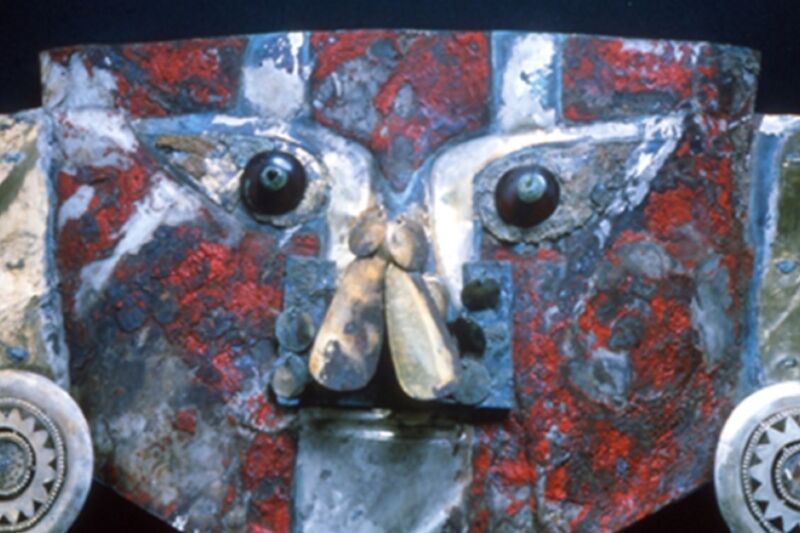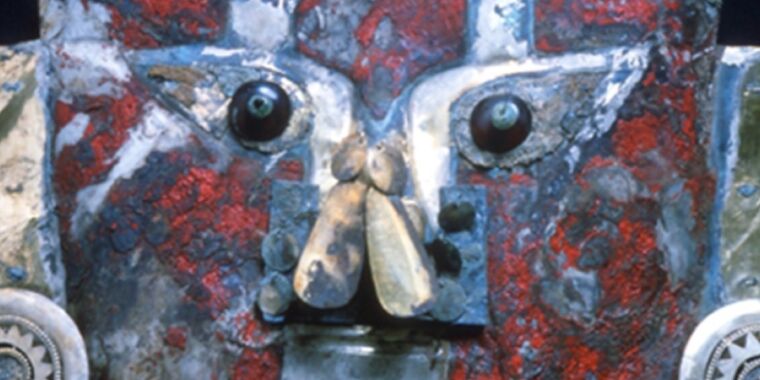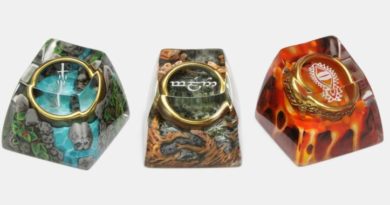1,000-year-old Peruvian mask’s red paint contains human blood, study finds
[ad_1]

Adapted from E. Pires et al., JPR, 2021
Ever since a 1,000-year-old gold mask was excavated from a tomb in Peru 30 years ago, archaeologists have puzzled over the surprising longevity of the red paint on its surface. According to a recent paper published in the Journal of Proteome Research, one of the secret ingredients is human blood, along with bird egg whites.
The Sican culture was prominent along the northern coast of modern Peru between the 9th and 14th centuries. There are numerous tombs of elite members of that society from the Middle Sican period (900-1100 CE) scattered throughout the region, but most of the tombs fell prey to looters. “Practically all Middle Sican gold artifacts in museums and private collections were looted from archaeological sites in modern times,” the authors wrote. “Once within illicit trade networks, these objects are commonly subject to various undocumented interventions to enhance their aesthetic qualities.”
This can involve stripping off paint and removing pigments, feathers, and bangles and cleaning the artifacts so carelessly that any ancient tool marks were smoothed over. That presents a significant challenge to researchers seeking to better understand the cultural significance of such artifacts.
That’s why this painted gold Peruvian mask is of such interest. It was carefully excavated in the early 1990s from an undisturbed tomb from the Middle Sican period located at the Huaca Loro temple mound. So its provenance has been clearly established, and its conservation history was carefully documented. The East Tomb, as it is known, contained the skeleton of a 40- to 50-year-old man, painted entirely red and placed upside down in the center of the burial chamber. The skull had been detached from the body and placed right-side up.
The skeletons of two young women were nearby, arranged in positions common to birthing and midwifery, with two child skeletons at a higher level, both in crouched positions. According to the authors, this indicates that those who buried the deceased leader hoped that he would be reborn. There were various objects in the tomb as well, including many metal artifacts. Excavators retrieved about 100 personal ornaments made of gold and silver-copper alloys (similar to the composition of today’s gold jewelry).
Among those objects was the crumpled red-painted gold mask that had covered the face of the male skeleton. The paint layer had remained intact for 1,000 years, intriguing scientists. So while the mask was being reshaped as part of the conservation efforts, researchers collected a few loose paint fragments and analyzed the composition.
Reddish paints from other Sican metal objects have proved to be a mixture of iron oxides, carob tree resin, and a substance that appears derived from fish bones. In the case of this particular gold mask, however, X-ray fluorescence identified mercury and sulfur, while X-ray diffraction showed the presence of cinnabar. The latter was typically only used for elite members of Sican society; ochre paint was used for people of lower rank.
But scientists had been unable to identify what material had been used as a binding agent—the secret to how the paint remained intact for so long. Co-authors Luciana de Costa Carvalho and James McCullagh, both from Oxford University, and their colleagues decided to take a closer look at a small sample of the red paint. Initial spectroscopic results showed that there were proteins in the sample, prompting a proteomic analysis using tandem mass spectrometry. Since they could not entirely rule out the possibility of keratin, skin, or even saliva contamination during sample handling and processing, they excluded those proteins from the final analysis.
Ultimately, the researchers clearly identified six proteins from human blood in the red paint, including serum albumin and immunoglobulin. There were also proteins like ovalbumin, found in egg whites. The proteins were highly degraded, so the authors couldn’t identify the exact species of bird’s egg used in the paint but suggest it was probably Muscovy duck—with a proteome nearly identical to that of chicken. Muscovy duck is known to be a food source to ancient Sicans. They were surprised to find no evidence of lipids, however, which are also common to both human blood and bird eggs. The researchers suggested that the lipids may have degraded during burial, or perhaps there were chemical interactions between the lipid molecules and the cinnabar.
“From an archaeological perspective, the use of human blood in the paint would not be surprising,” the authors wrote, pointing to a recent study of the remains of human sacrificial victims from Sican, indicating that many appeared to have been deliberately cut on the neck and chest to maximize bleeding. Their finding “lends weight to a hypothesis that application of this red paint on the entire deceased skeleton symbolized intensely red oxygenated blood, ‘life force’ essential for the desired effect [rebirth] to take place.”
That said, “It was not possible to analyze other artifacts or the surrounding sediments and there remains the possibility that the paint sample could have been contaminated from other materials,” the authors wrote, adding that this nonetheless seems unlikely. Given the small samples available for analysis—these artifacts are fragile and highly precious—having positive and negative control samples from excavations or archaeological sites where such items are found would make future analyses more robust. Still, their findings could eventually help archaeologists authenticate the various masks in collections around the world with no clear provenance.
DOI: Journal of Proteome Research, 2021. 10.1021/acs.jproteome.1c00472 (About DOIs).
[ad_2]
Source link




